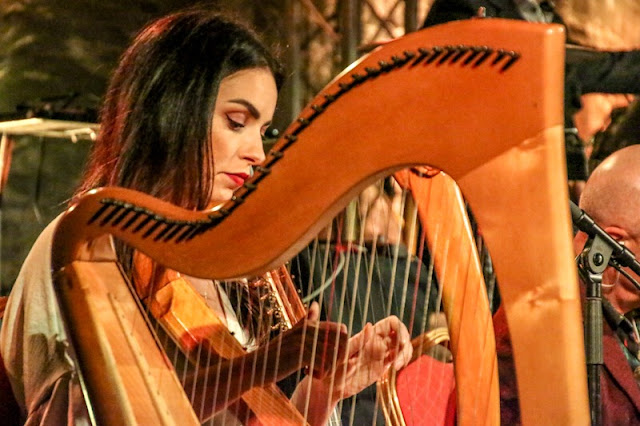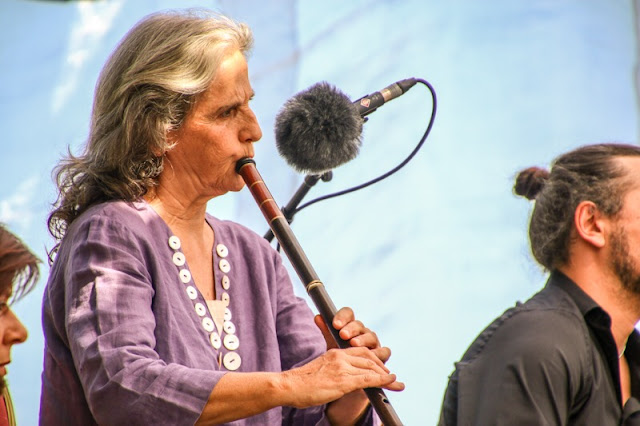From a somber Canticum Novum performance, through a masterly Celtic bagpipe display, to an all female Rajasthani delight, it was a mixed day at the Fes Festival
 |
| Canticum Novum |
Canticum Novum - France - Jardin Jnan Sbil
Around half of the seats were full this afternoon back in the gardens. After only a short delay, a dozen artists soberly took to the stage. Three vocalists held only books, and the rest clutched various traditional instruments.
Weaving together sacred music from across the Abrahamic religions, the ensemble incorporate Christian, Jewish and Moorish musical heritage. ‘Aashenayi’ refers to the musical encounters between these cultures that occurred during the reign of Ottoman Suleiman the Magnificent.
When the Empire was at its height, Suleiman utilised his strategic location to be a centre of trade. But not just trade of goods, but of ideas, of stories and of melodies. Fitting, therefore, as an addition to Fes Festival, the ensemble brought together a concoction of cultures. This diversity was evident not just in the tones but in the costumes, the artists and the instruments on stage.
 |
| Lap harp |
The vocalists, two females and a male, played up the chemistry by doing romantic duets, mostly in Latin. The most entrancing instrument was a lap harp, played by a man deep in concentration, speeding up until his fingers risked detaching.
Although each instrument was expertly played, there was something important missing from the stage: joy. Perhaps typical of this genre, which was typically performed in rather formal settings at the request of elite sponsors, there was a rigidity to the performance that prevented one from getting lost in their harmonies.
Carlos Nunez - Master of the Gaita Bagpipes - Spain
“Tradition is more important than ever,” declared Carlos, whilst explaining the roots of Celtic music, which was exchanged via the Atlantic between the northern isles of Scotland and Ireland to the southern shores of the Spanish Mediterranean.
Gaita bagpipes are local to his hometown in Spain, and Carlos was not just a master of these pipes but of a range of wind instruments that he chose between, stacked next to him in a pile.
“This is the music of the mornings” he announced whilst grasping his bagpipes, despite it being late in the day. He was joined by guitarist Pancho and his brother on drums. But there remained two empty seats on the stage.
 |
| Mary Ryan |
Gesturing out to behind the audience, Carlos aroused confusion. Suddenly, all the cameras began to turn and the audience followed. Appearing from within the aisle was brunette violinist Mary, moving and playing as if it were second nature. She paused at the stage entrance where the stage technicians sat. Eventually they got the idea and moved out of her way while she multitasked her way onto the stage.
Mary Ryan softly introduced herself and said they would next sing a song something from her native Ireland. The sweet girl then transformed into a fiery musician, rocking up and down with her violin as if it were an extension of her arm.
All of the performers were dancing simultaneously as they played, jumping up and down in unison like an Irish jig. The audience couldn't resist the beat and were tapping their feet. One brave attendee even tried out some Irish dance near the front of the stage.
The bagpipes demanded the audience’s attention, and if they weren't already wowed, next to join on stage was an angelic harpist Keira Taff, who switched between two differently sized harps throughout the performance. From Belfast, she explained in English that the next melody was from the ancient scripts of the time of King Arthur. With rustic moody tones, the ensemble played finally as a complete set.
 |
| Keira Taff |
New instruments kept being thrown into the mix. Carlos next asked his guitarist Pancho to show the audience a smaller Andalusian style guitar, which made a deep and melancholic sound. A traditional Maghrebi style bagpipe was then whipped out as he asked everyone to clap along to the beat.
Energised and perhaps a little deafened, the audience departed. A fair few sneaked off before the end, likely in the hope of reaching the next concert at the Ben Youssef Complex, an elusive venue that takes some determination to find.
Many on their way questioned the scheduling of the festival, complaining that passes were made redundant as there had been no attempt to allow time for the audience to move between venues.
Meera- India
Taking us to another world, Meera from India performed a dance that was so expressive it was akin to physical theatre. But it wasn't just because of Meera that the audience was in a new world, but also as we were in the mysterious Ben Youssef Complex.
 |
| The bride bows to Lord Krishna |
As Fes medina has over 8,000 streets, finding the venues for the festival’s second ‘Night in the Medina’ is a challenge not the be overstated. With far greater foresight and intelligence than the festival management, young Moroccan boys arrived at Jnan Sbil after the last performance hoping to make a day’s money escorting the audience to the next venue. Only the ones lucky enough to find an escort made it to see Meera’s magic.
The dance told the story of a young girl so in love with her Lord Krishna, she has no more space for another man. Set to be wed, she debates over and over with her mother's and aunties, but to no avail. Shy and nervous, she goes through with the marriage. However after arriving back in the marital home, she bows down in service to Lord Krishna instead of her new husband.
 |
| Meera is married to her husband |
The group of eight dancers led the audience through this story with elegance and poise, in traditional Rajasthani fashion, rocking back on their feet wrapped in bells, always with their hands perfectly in poise. Now their dancing was only half the spectacle, their colourful and delicately crafted outfits, which are traditionally worn in dance, glittered as they turned in circles, underscored with the percussion of their ankle bracelets.
The husband was also played by a woman, but dressed in traditional groom wear, a turban with a long kameez. As Rajasthani grooms traditionally ride to the bride's home on horses, they enacted the arrival of the groom, miming the riding of a stallion.
The all-female ensemble didn't stop smiling for one second, and the audience matched their glee. The local audience was greater tonight, and were enthralled, many of them being huge fans of Bollywood and Indian dance movies.
Orbiting around the statue of Lord Krishna, always returning to him to give puja (offerings), the dancers gave a flavour of how Hindus worship and how their religion entwines with their daily lives. The story continues until the young bride has aged, and she shared her woe at how life didn’t turn out as she had dreamed. Nevertheless, always there to give her solace and never leaving her side, was her one love, Lord Krishna.
The addition of this piece makes the Fes Festival truly inclusive, showcasing not just the sacred music and dance of Abrahamic faiths but of all faiths and traditions from around the world.
Reviews and photographs: Venetia Menzies
Tomorrow at the Festival
KOL COLÉ – GERMANY - 18:00 - Venue: Synagogue
SVETLANA SPAJIC VOCAL ENSEMBLE AND CHERIFA KERSIT – SERBIA & MOROCCO - 19:00 Venue: Dar Adiyel
WORLD YOUTH BAROQUE ENSEMBLE - 20:30 - Venue: Jardin Jnan Sbil
OBINI BATÁ – CUBA - 22:00 - Venue: Complexe Ben Youssef
Weather: Partly cloudy and 31 Celsius
SHARE THIS!





No comments:
Post a Comment